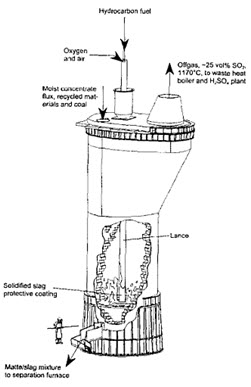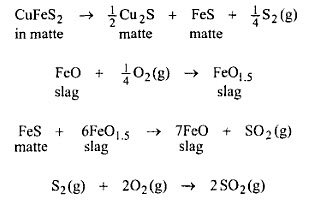Ausmelt / Isasmelt Matte Smelting: Part One
Abstract
Ausmelt and Isasmelt technologies represent significant advances in copper smelting, originating from research conducted by the Australian Commonwealth Scientific and Industrial Research Organization in 1971. These pyrometallurgical processes utilize top-lancing technology for injecting materials into molten baths, enabling efficient processing of moist concentrate feeds without prior drying. The technology employs oxygen-enriched air blown through vertical lances into matte/slag baths within tall cylindrical furnaces, producing copper matte and strong SO2 offgas. Unlike flash smelting, these processes conduct smelting reactions primarily in the bath rather than above the melt, with dissolved magnetite serving as a catalyst. Commercial applications worldwide have established these technologies as significant factors in modern copper smelting operations.
Introduction to Ausmelt/Isasmelt Copper Smelting Technology
The development of Ausmelt and Isasmelt copper smelting technologies began in 1971 when researchers at the Australian Commonwealth Scientific and Industrial Research Organization (CSIRO) initiated investigations into top-lancing technology. Their initial focus involved injecting coal into tin slags to improve reduction kinetics, which ultimately led to breakthrough innovations in pyrometallurgical applications.
This pioneering research resulted in the development of versatile technology suitable for various pyrometallurgical applications, including smelting and converting of sulfide concentrates. Today, two separate organizations market this technology under the names Ausmelt and Isasmelt, both based on the foundational work completed at CSIRO during the 1970s.
The technology has achieved widespread commercial application globally and has become a significant factor in modern copper smelting operations. Both Ausmelt and Isasmelt smelting processes share common technological foundations while offering distinct operational advantages.
Fundamental Operations of Ausmelt/Isasmelt Processes
Primary Smelting Process
Ausmelt/Isasmelt copper smelting involves dropping moist solid feed materials into tall cylindrical furnaces while simultaneously blowing oxygen-enriched air through vertical lances directly into the furnace's matte/slag bath. This process generates two primary products: a matte/slag mixture and strong SO2 offgas.
The matte/slag mixture undergoes periodic tapping into fuel-fired or electric settling furnaces for separation. The settled matte, containing approximately 60% copper, proceeds to conventional converting operations. The resulting slag, containing 0.70% copper, is discarded as waste material.
Offgas Management and Recovery
The offgas stream, containing 25% SO2, is drawn from the top of the smelting furnace through a vertical flue system. This gas stream passes through a waste heat boiler for energy recovery, followed by gas cleaning systems, before proceeding to sulfuric acid production facilities. A small quantity of oxygen is blown through the side of the smelting furnace or lance (approximately halfway up) to ensure sulfur exits the furnace as SO2 rather than S2, preventing sulfur condensation in the gas cleaning system.
Energy Sources and Thermal Management
Most energy required for smelting operations derives from oxidizing the concentrate charge. Additional energy comes from combusting various fuel sources, including oil, gas, or coal fines blown through the vertical lance, as well as coal fines incorporated into the solid charge.
Feed Materials and Preparation Requirements
Raw Material Characteristics
Ausmelt/Isasmelt feed materials consist of moist concentrate, flux, and recycle materials, which are sometimes pelletized for optimal handling. Unlike many traditional smelting processes, feed drying is unnecessary because smelting reactions occur within the matte/slag bath rather than above it. The use of moist feed materials also provides the additional benefit of decreased dust evolution during processing.
Oxygen Enrichment Standards
Oxygen enrichment of air blown into Ausmelt/Isasmelt furnaces represents standard operational practice. The blast typically contains 50 to 60 volume percent O2. Oxygen levels exceeding this range tend to cause excessive lance wear, limiting operational efficiency. Due to this upper limit on oxygen enrichment and the presence of moisture in solid feed materials, autothermal operation is typically not achieved.
Supplementary Fuel Requirements
Instead of relying solely on autothermal processes, hydrocarbon fuel addition becomes necessary. Ausmelt/Isasmelt furnaces are specifically designed to utilize natural gas, oil, and coal as supplementary fuel sources. Maintaining cool lance tips is crucial for reducing lance wear, which often necessitates adding coal to the feed as a partial substitute for flammable fuel oil and natural gas.
Isasmelt Furnace Design and Lance Technology
Furnace Construction and Specifications

Figure 1: Isasmelt furnace configuration
The furnace consists of a vertically aligned steel barrel measuring approximately 3.5 meters in diameter and 12 meters in height. Depending on size specifications, these furnaces can process up to 3,000 tonnes of concentrate per day.
The furnace interior features chrome-magnesite refractory lining, sometimes backed with copper water-cooling blocks for enhanced thermal management. The roof construction utilizes water-cooled copper slabs or steel panels to withstand the extreme operating temperatures and corrosive environment.
Smelting Mechanisms and Reaction Chemistry
Fundamental Process Differences
Ausmelt/Isasmelt smelting differs significantly from flash smelting in that smelting reactions occur primarily within the bath rather than above the melt. This fundamental difference results in a distinct reaction sequence that offers several operational advantages, as show in the figure below.

Figure 2: Smelting reaction sequence
Catalytic Role of Magnetite
It is commonly believed that dissolved magnetite in the slag serves as a catalyst for the overall smelting process. The reaction sequence depends on maintaining approximately 5% magnetite content in the slag, which requires specific operating conditions including low bath temperatures (1150-1200°C) and controlled silica/iron ratios (0.7-0.8 for Isasmelt, 0.6-0.7 for Ausmelt).
Conclusion
Ausmelt and Isasmelt technologies represent significant advances in copper smelting, offering efficient processing of moist concentrates while maintaining high copper recovery rates. The technology's success stems from its innovative approach to conducting smelting reactions within the bath, utilizing oxygen-enriched air injection through vertical lances, and maintaining optimal magnetite concentrations for catalytic efficiency. These processes have established themselves as important alternatives to traditional smelting methods, providing operational flexibility and environmental benefits through improved offgas management and reduced dust evolution.
Total Materia
Total Materia è la principale piattaforma informativa sui materiali, che fornisce le più ampie informazioni sulle proprietà dei materiali metallici e non metallici e altri dati sui materiali.
Tutte queste informazioni sono disponibili in Total Materia Horizon, lo strumento di informazione e selezione dei materiali per eccellenza, che offre un accesso impareggiabile a oltre 540.000 materiali e a dati di riferimento curati e aggiornati.
Il totale di Materia Horizon comprende:
- Dati completi sulle proprietà meccaniche e fisiche
- >80 standard globali e relative equivalenze
- Strumenti di precisione per il confronto e l'analisi che semplificano il processo di selezione.
- Dati di sollecitazione-deformazione, formabilità, fatica, scorrimento e frattura.
- Esportazione in oltre 25 formati CAx.
- Trattamento termico, metallografia, informazioni sulla corrosione
- Dati su saldatura, brasatura e adesivi.
- Fonti aggiornate mensilmente e tracciabili garantiscono l'affidabilità